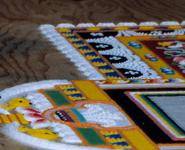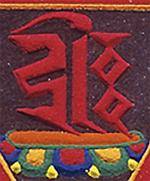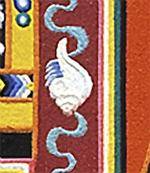
Hayagriva Mandala
- monk
- Seraje Monastery, Tibetan
- Born: Tibet
- Work Locations: India
In September of 1996, three monks from the Seraje monastery in southern India—Losang Lungrig, Sand Mandala Master; Sonam Woser, Sand Mandala Artist; and Geshe Thubten Sonam—traveled to the Denver Art Museum to create this sand mandala. The Seraje monastery is primarily a center for education and religious training, and also operates a farm, dairy, printing press and crafts division. Monks with specialized talent are selected to receive further training in chanting, ritual dance, painting, and other activities. Monks who create sand mandalas must have advanced artistic skills, dexterity, and spiritual aptitude. They need to be able to visualize the design, with all of its many details, before construction of the mandala begins.
Monks start by drawing a simplified diagram and then begin applying the sand, starting at the center of the diagram and working out toward the edge. The sand is applied using a metal instrument to scrape grains out of a narrow metal funnel. A wooden scraper is used to make tiny adjustments and corrections. Traditionally, a mandala is dismantled after it has been completed, to serve as a reminder of the impermanence of all things. The mandala at the DAM has been preserved with special permission from the abbot of Seraje Monastery.
In Tibetan Buddhism, the mandala is a very powerful symbol. The process of making the mandala is a form of meditation and act of faith in itself. The slow, meticulous work that is required to create a mandala reinforces the Buddhist belief of emptying one’s mind and being in the present. A sand mandala becomes a visual symbol that is beautiful in its conception, composition, color, surface texture, imagery, and intricate details.
Mandalas depict the “homes” of certain deities, including their palaces and surrounding grounds. This particular mandala is meant to be inhabited by Hayagriva, the patron deity of the Seraje monastery. Hayagriva destroys passion and ignorance, the two obstacles on a human’s path to enlightenment. He has a red body, three faces, and a horse’s head protruding from the top of his center head. He is represented here by a written character that sits in the center triangle. This character is a Sanskrit syllable, referred to as a “seed syllable,” for it is said to be the “seed” of the deity.
Details

Sand
The mandala was made using various colors of marble sand, arranged to create an intricate and symbolic design. The monks used sand from 29 small bowls, each with a different color. These colors were also mixed in some areas. In areas where a lot of sand has been applied the sand forms small peaks.

Hayagriva
The patron deity of Seraje is represented here by a written character called a “seed syllable.” The seed syllable sits on a lotus flower within the triangle at the center of the mandala.

Skulls
Inside the innermost ring is a series of tiny skulls. These serve as reminders that life is transitory.

Conch shell
Within the border of the square there are four conch shells, one on each side. The conch shell symbolizes the voice of Buddha explaining the doctrine. Conch shells can be blown like a horn and are used to call people to worship.

Skeletons
The outer ring with the black background probably represents our world. In this area, there are skeletons suggesting burial grounds. Such scenes symbolize the impermanence of human existence
More Resources
Wheel of Healing Mandala
In February 1994, a group of Tibetan Buddhist monks from Ganden Jangtse Monastery in southern India constructed the "Wheel of Healing" sand mandala at the Denver Art Museum.
The Mandala of Compassion at Dartmouth
This timelapse video from Dartmouth University shows monks from the Namgyal Monastery and Institute of Buddhist Studies and the sand mandala they created at the Hood Museum of Art. After working on the mandala for three days, the monks then cleared the mandala (symbolizing the impermanence of life) and poured the sand into a pond, disseminating it into the world.
Websites
Exploring the Mandala
A website about the Tibetan Buddhist Sand Mandala, including other great web resources about mandalas and Tibetan Buddhism
Lost Treasures of Tibet
A web resource providing a class-room activity where students create mandalas
Tibetan Buddhist Sand Mandala
A web resource containing a video of a sand mandala being constructed at St. Lawrence University.
Daily Schedule of a Tibetan Monk
A web-resource with a simple breakdown of the daily schedule at the Tsechen Damchos Ling Buddhist Monastery in Southern India.
First-hand Account of Daily Monastery Life
A web-resource with a first-hand account of daily life of a Tibetan Monk at the Sera Monestery in India. The monks who created Denver Art Museum’s preserved mandala came from this monastery.
Sera Monastery
This website includes information, photographs and news about the Sera Jey (also called Sera or Serje) Monastery, a university for advanced Buddhist studies and practice in Southern India. The monks who created the Denver Art Museum’s preserved mandala came from this monastery.
History of Tibetan Buddhism
A web-resource containing a brief history of how Tibetan Buddhism came to India. Also has a history of Gaden Shartse monastery and their school goals.
Books
Bryant, Barry. The Wheel of Time, Sand Mandala. New York: HarperCollins Publishers, 1992.
A history of the mandala that looks at the step-by-step process and the transformation of consciousness through its creation.
Farber, Don. Tibetan Buddhist Life. New York: DK Publishing, 2003.
A compilation of stunning photography and text that explores the development of the tradition, daily monastic life and their arts.
Goldsworthy, Andy. Time. New York: Harry N. Abrams Inc., 2000.
A book devoted to artist Goldsworthy’s work, which also parallels the mandala’s concept of ritual and impermanence by using only natural materials in the natural world.
Nomachi, Kazuyoshi. Tibet. Boston: Shambala Publications Inc., 1995.
A photographic journey through Tibet that looks into lives of the different kinds of people that inhabit the land.
Pearlman, Ellen. Tibetan Sacred Dance. Rochester: Inner Traditions, 2002.
A book about the history, cultural significance, and steps of various dances in the Tibetan culture.
Rinpoche, Khandro. This Precious Life. Boston: Shambala Publications Inc., 2003.
A book containing the fundamental ideas of the Tibetan Buddhist practice including the Eight Freedoms, the Great Impermanence of Death, the Six Realms and Karma.
Tresidder, Jack. Symbols and their Meanings. London: Duncan Baird Publishing Ltd., 2000.
An exploration into the origin and various meanings of core universal symbols.
Children's Books
Thompson, Mel. Buddhism (World Religions Series). North Vancouver, B.C.: Walrus Books, 2004.
For ages 9-12, this book explores Buddhism, with a glossary and resource guide.
Funding for object education resources provided by a grant from the Morgridge Family Foundation. Additional funding provided by the William Randolph Hearst Endowment for Education Programs, and Xcel Energy Foundation. We thank our colleagues at the University of Denver Morgridge College of Education.
The images on this page are intended for classroom use only and may not be reproduced for other reasons without the permission of the Denver Art Museum. This object may not currently be on display at the museum.
